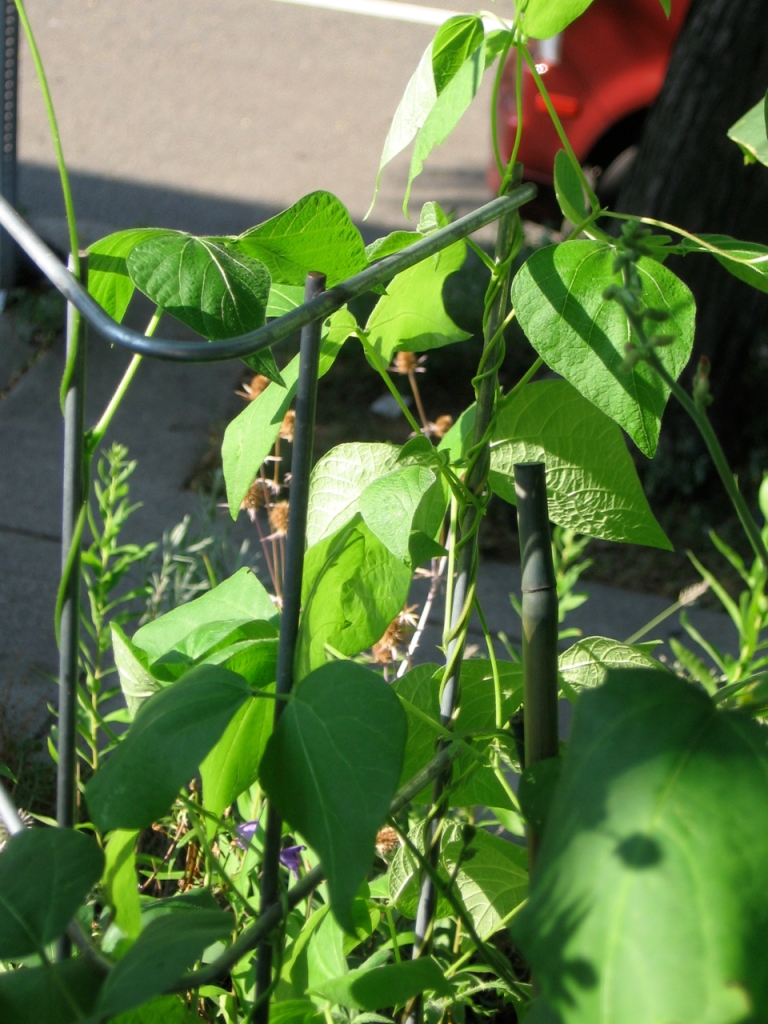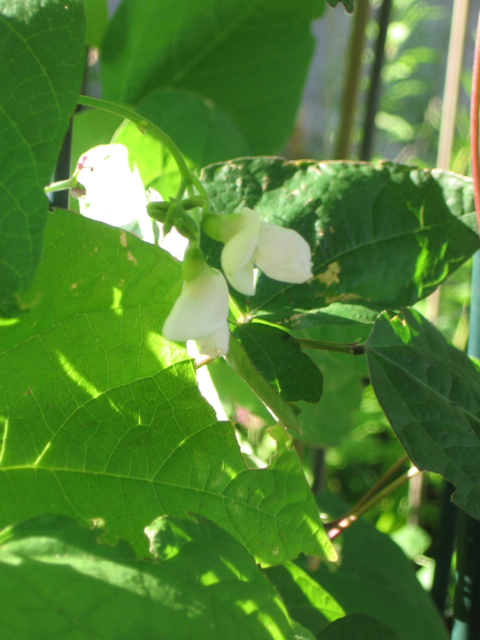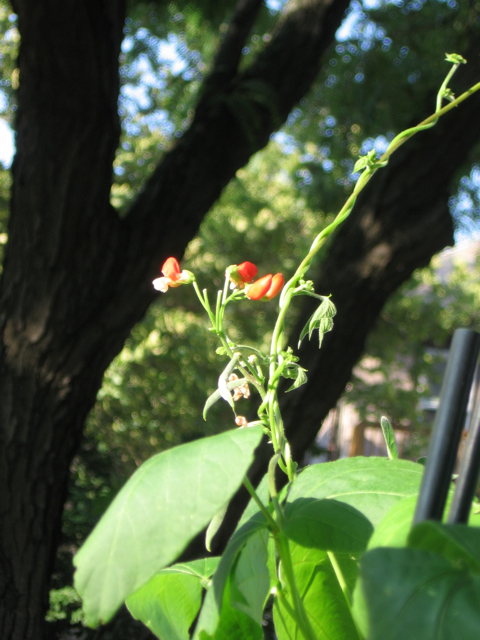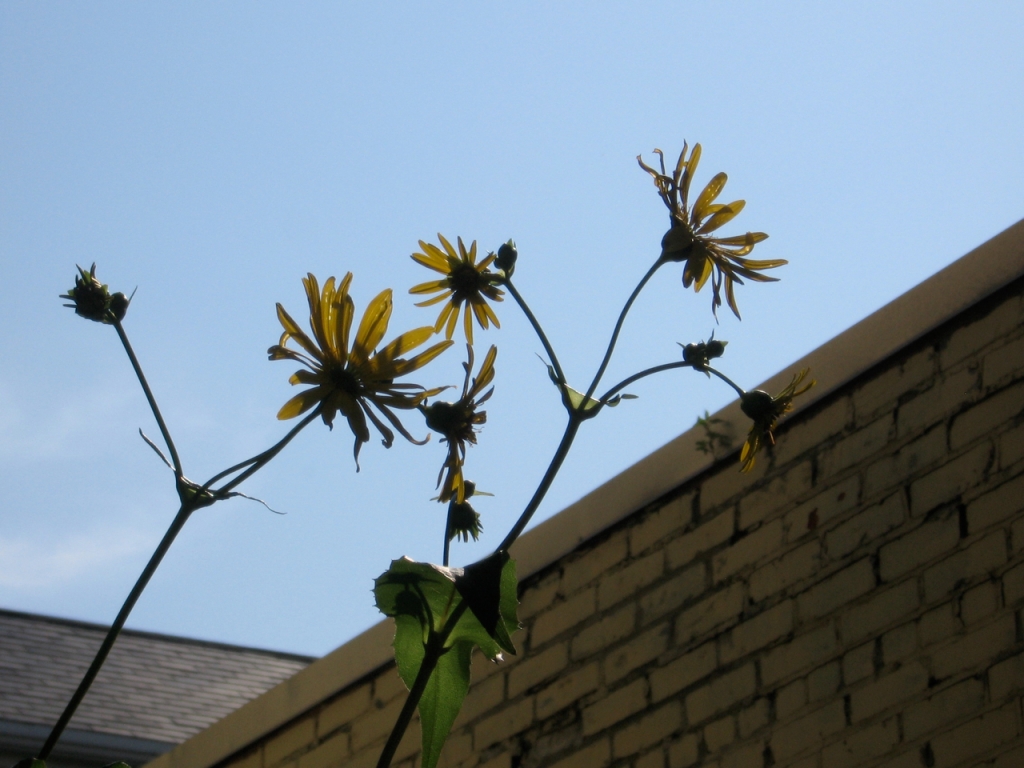I’m trying to be better about updating, so I’m trying to update at least every couple of days. In that spirit, here is what’s going on in the garden today:
*After two days of heat (mid-90s F two days ago, around 90 F yesterday) and sunshine, the weather has drastically changed, and the temperature is cooler now, at midday, than it was when I went to bed last night (when it was in the mid-70s F). It’s in the 50s F with a cool ocean breeze and it is thickly grey. We have had a very dry May after a cool, wet early spring, and it was quite nice to feel a medium rain as I was walking home from the nursery, umbrella-less, this morning. The rain didn’t last very long (maybe 10-15 minutes), but it continues to look as if it could start again at any moment. I hope it does. I continue to believe that no matter what watering devices and watering sources we humans come up with, there’s no substitute for actual real rain for plants.
*Speaking of the nursery: While there today I got some more annuals – flowers and coleus (I’ve been disappointed that their selection of herbs has remained pretty static in recent weeks, and am looking forward to the farmers’ market starting this coming week, when I will have new herb plants to choose from!) – and three crop plants, two of them heirloom tomatoes – one each of ‘Sioux’ and an Italian one – and a Japanese cucumber plant, which I think has ‘Kyoto’ in the name. The potted cucumber actually has two seedlings growing in it instead of one. We’ll see if they both survive. ‘Sioux’ is supposed to do better in heat than most tomatoes (which I actually didn’t realize till I brought it home; I just liked the description when I was at the nursery), so I’m thinking of planting it in the front garden instead of in a pot.
*The ‘fruit days’ period (in biodynamic parlance) ends shortly today, so I went out after I got home and sowed a runner bean I was given yesterday, ‘Aztec Half Runner,’ which is supposed to be quite dwarf, about seven inches tall, as well as my edamame (as I discussed possibly doing in my last post) – soy beans ‘Lucky Lion,’ ‘Moon Cake,’ ‘Kouri,’ and ‘Tankuro’ – and the melons (‘Chanterais,’ ‘Hale’s Best Jumbo,’ and the rather dully named ‘Old Original’) and other cucumber, also a Japanese one (‘Soyu’). I am, in fact, somewhat sensitive to cucumbers, and so I thought I would try growing the ones that we English speakers call ‘Japanese,’ which are supposed to have both a different chemical composition and a different taste than European cucumbers. ‘Moon Cake’ is a bit of a mystery to me – it seems to barely be offered by any companies (if even that), and even the one that I ordered it from over the winter no longer lists it on their website! It was just introduced earlier this decade, according to what I read this morning, and is supposed to be much taller than most edamames, averaging 5-6 feet. My other three are all from Kitazawa Seed Co., one green seeded, one brown seeded, and one black seeded. (See their descriptions pasted below.) Green seeded soybeans are by far the most common ones in the US, perhaps because many catalogs erroneously list other seed colors as being only for dry beans (in reality, whether the beans can be eaten fresh has nothing to do with the color of the planted seed).
*The purple-podded beans have started to sprout, joining earliest bean ‘Arikara Yellow.’ So far, ‘Blue Coco,’ ‘Trionfo Violetto,’ and ‘Purple Podded’ are coming up. (See descriptions pasted below.) The runner beans have yet to show sprouts.
*I noticed while I was out sowing that the blueberries seem to have doubled in leaf numbers just since I mulched them with compost two days ago.
*The fava/broad beans are doing even better now that it’s cooled off. They’ve increased their bloom count. The ants are obsessed with wandering back and forth on them, like they always do. I’ve never figured out why. (There are certain other plants in the garden that they are also obsessed with – especially my autumn-blooming colchicums, but only when they’re in bloom.)
*Continuing my disappointment with Cook’s Garden (sure do wish I’d remembered Burpee’s had bought them out before I ordered), they just notified me yesterday that they were finally shipping my shallots. It had been so long that I had actually forgotten I’d ordered shallots from them! The notice piously said that they were shipping at the right time for me to plant them in my area, but it is well past the best time to plant shallots here. Johnny’s Select Seed sent me their shallots a couple of months ago, and Moose Tubers (the root slips division of Fedco Co-Op) sent theirs a few weeks later. (Both those are in Maine. Cook’s Garden is farther away, in Pennsylvania.) Well, hopefully they will be OK planted this coming week (they have yet to arrive), even though they should have been sent earlier. My already-planted shallots appear to be doing well.
…
Soybean ‘Kouri’ Brown-seeded soybeans are uncommon in the United States. They are highly prized in Japan for their sweeter and nuttier flavor compared to the traditional green/tan seeded soybeans. Even though the seed for planting is brown, you will find the color of the bean dark green at harvest and it retains this color when cooked. The pod’s pubescence is light brown. The plant habit is semi-upright growing about 2 feet tall. Warm day temperatures and cool night temperatures are important for good results. This is an early maturing variety and seeds are sown from early May after danger of all frost to late June and harvested from late July to early September. Boil in salted water and bite or squeeze the beans from the pods directly into your mouth. Maturity: Approx. 85 days (Kitazawa Seed Co.)
Soybean ‘Tankuro’ In Japan, the black-seeded soybeans are noted as having a richer and sweeter flavor compared to the traditional green/tan seeded soybeans. Even though the seed for planting is black, you will find the color of the bean dark green at harvest and it retains this color when cooked. The pod’s pubescence is light brown. The plant habit is semi-upright growing up to 2½ feet tall. Warm day temperatures and cool night temperatures are important for good results. This is an early maturing variety and seeds are sown from late April after danger of all frost to early June and harvested from mid July to late August. Boil pods in salted water and bite or squeeze the beans from the pods directly into your mouth. Enjoy! Maturity: Approx. 85 days (Kitazawa Seed Co.)
Soybean ‘Lucky Lion’ This variety of soybean is prized for its high yield and excellent nutty flavor. There are typically 3 beans per each bright green pod. This is a mid-early maturing type variety, indeterminate type and grows about 2 feet tall. Warm day temperatures and cool night temperatures are important for good results. Prepare as an appetizer by boiling pods in salted water and serve cooked beans or “edamame.” Maturity: Approx. 75 days (Kitazawa Seed Co.)
Pole Bean ‘Trionfo Violetto’ Purple climbing French type bean. 75 days. Beautiful bean, long, slim and very crisp. Makes a stunning fresh bean salad when mixed with one of our green and yellow french beans. Turns green when cooked. Like most French type beans, should be picked when no thicker than a pencil for greatest tenderness and best flavor. (imported from an Italian seed company)
Pole Bean ‘Blue Coco’ 59 days. Distinctive flavor and color. [Pre-1775 French heirloom.] The name ‘Blue Coco’ refers to the bluish-purple color of the pods and the chocolate (coco) color of the seeds. Leaves are green, tinged with purple. The fleshy, slightly curved flattened pods range from 6 to 7-1/2 in. long, and have a nice meaty flavor. Outstanding characteristics of this variety are color and ability to produce under hot, dry conditions. (Southern Exposure Seed Exchange) I love ‘Blue Coco’ so much that here is a second description about it to entice you: Blue Coco (pre-1775) – Also known as Purple Pod and Blue Podded Pole. One of the oldest of the purple podded pole varieties, this rare variety was known in France as early as 1775. The young pods are delicious harvested young as snap beans and the beige to “coco” colored seeds have a meaty texture when used as a dry bean. The coloration of the dry seed varies with soil and climate. It is very durable and excellent for short season climates because it is quite early for a pole bean and is also very tolerant of adverse conditions. (60 days for snaps) Pole. EXTREMELY RARE. (pasted from Heritage Harvest Seeds in the UK)
Pole Bean ‘Purple Podded Pole’ This is a heavenly, almost fluorescent purple pole bean, hailing from the Ozark mountains. This lovely heirloom beauty was found growing in a garden the 1930’s by the old Henry Fields Seed Company. It is most likely of European origin and probably dating much earlier than that . Very vigorous grower of vines reaching easily over 6 -8 feet , but not out of control like some pole types I have grown. […] These gorgeous snap beans are stringless, nice and meaty . They are less than 1/2 inch across by about 5-7 inches long. The entire bean plant just glows and is quite ornamental with purple vines and veins in the leaves, and as you can see in the photo lovely bi-colored purple flowers as well. Fairly early for a pole sort. Seed is a buff brown color, with a hint of lavender. (Amishland Seeds)





Recent Comments